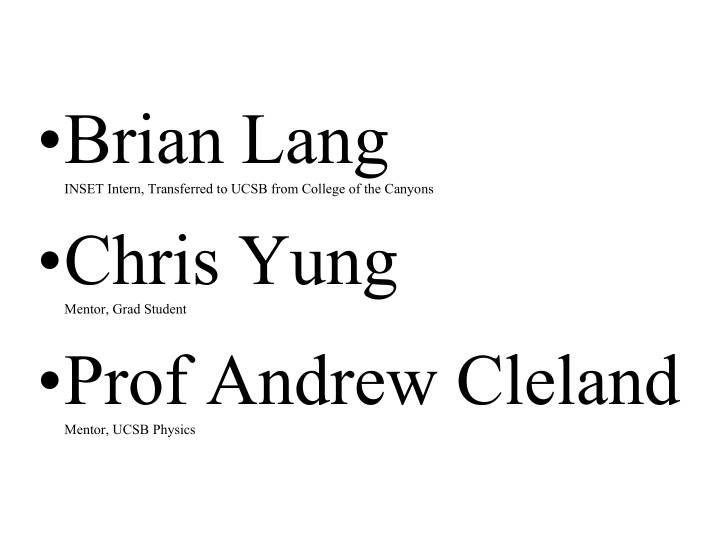



•Brian Lang INSET Intern, Transferred to UCSB from College of the Canyons •Chris Yung Mentor, Grad Student •Prof Andrew Cleland Mentor, UCSB Physics
CREATION OF MAGNETIC TUNNEL JUNCTIONS WITH A THERMAL EVAPORATOR Intern: Brian Lang, UCSB Program: INSET Mentor: Prof Andrew Cleland, Chris Yung UCSB Physics Department Magnetic Tunnel Junctions have a definite usefulness towards the future of hard drive technology due to their sensitivity. These junctions are composed of a thin film sandwich of ferromagnet-insulator- ferromagnet and produce strange properties. Due to the quantum mechanical effect of tunneling, a voltage across the junction is affected by a magnetic field, and thusly can be used to measure a very sensitive field. Due to this sensitivity, the applications in the field of hard drives would lead to much higher data density, and as it is a property of spin, smaller power usage. My research over the summer was dedicated to the production and testing of these Magnetic Tunnel Junctions. This included fixing and modifying the thermal evaporator, writing the targets with electron beam lithography on the Scanning Electron Microscope, evaporation, and probing the finished product. The evaporation was originally tested with gold for continuity, then aluminum for the junction, and then nickel for the magnetic properties.
or or where do we get our stuff? where do we get our stuff? This project is funded internally. As of yet, there’s no grant or corporate sponsorship. However, since the magnetic tunnel junctions could be extremely sensitive magnetic field sensors, there could be some interest in the future from computer hard drive companies. I am currently supported by a stipend from the generous people at the INSET internship program.
• The purpose of this project is to create magnetic tunnel junctions in the lab for testing and future study. • My specific role has been to upgrade the thermal evaporator, design and draw the magnetic tunnel junction patterns to be written onto Gallium Arsenide wafers, use the evaporator to form the junctions, and finally to test the completed junctions.
A magnetic tunnel junction is a thin film component made by layering ferromagnet-insulator-ferromagnet. The insulating layer is so thin that electrons tunnel through it under the influence of outside voltage. The alignment of the magnetic fields in the ferromagnets also affects the rate of tunneling by impeding current in the aligned pair.
The thermal evaporator we operate in the lab functions very simply. A high current (100A) is run through the sample boat at the bottom. The boat heats up, the metal inside evaporates and sprays all over the inside of the chamber. The crystal oscillator reads the amount of metal deposited, and shows us when the desired thickness is reached. When it is, we close the shutter and that isolates the target wafer from the evaporating metal.
Tilter stage adapter Diffusion pump plate I’ve created several parts for the thermal evaporator, some of which are shown above. Shutter
• First using a PC, we draw a pattern in DesignCAD that we want written onto the Gallium Arsenide or GaAs wafer. • Then we spin on 2 different layers of resist to the wafer. LOR30B, and PMMA A5.5 • Next we place the sample in the Scanning Electron Microscope, switch control of the SEM over to the computer, and run a program that writes our pattern into the wafer. • Finally, we develop the wafer by washing away the exposed resist. This leaves a valley in the wafer in the shape of our pattern.
• Using the GaAs wafer, we evaporate the desired metal at an angle of 45 degrees • Then we oxidize the surface of the deposition by adding 400 mill torr O 2 into the chamber • Finally we change the angle to the opposite 45 degrees and evaporate the final layer. The junction is formed where they barely overlap as shown by the circle below.
• Gold Test Junction (above left) • 5k � Al-Al Tunnel Junction • 7k � Al-Ni Magnetic Tunnel Junction (above right)
• For the next step, we’re going to attempt to make Ni-AlO-Ni Magnetic Tunnel Junction. Nickel has been very difficult to deal with due to its high melting point, and low vapor pressure. • We also plan to try Cobalt, however that looks to have the same problems that we encountered with Nickel. • Finally, we will play around with other types of ferromagnetic materials. (Niobium, Cu-Ni…)
Thanks to : Thanks to : • IQUEST and the entire INSET program staff • Andrew Cleland, Chris Yung, Dan Schmidt, Rob Knobel, David Wood, Sequoyah Aldridge and Loren Swenson for putting up with all the questions! • Mike and Jeff at the Machine Shop
Recommend
More recommend